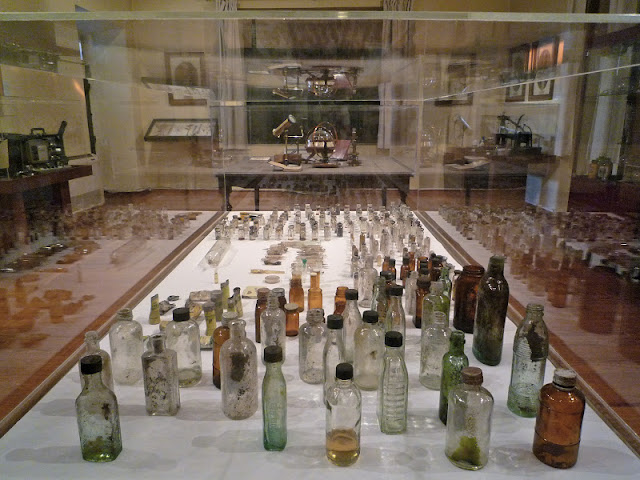Sanatorioproject 2012
στο Μουσείο Ιστορίας του Πανεπιστημίου Αθηνών
Περισσότερες πληροφορίες: http://sanatorioproject.blogspot.com/ , http://sanatorio-archives.blogspot.com/Συμμετοχή με το έργο Fragments, ευρύματα από τον κλίβανο του Σανατορίου, μεταβλητές διαστάσεις.
Participation with an installation titled Fragments comprising artifacts found in the sanatorium's incineration furnace, variable dimensions.
Κατάλογος έκθεσης: Sanatorio Project
Το Σανατόριο «Ζωοδόχος Πηγή», που ίδρυσε στις αρχές του 20ου αιώνα ο γιατρός Γεώργιος Καραμάνης, βρίσκεται ακόμα εκεί, στα Χάνια Πηλίου, ανάμεσα σε οξιές και πλατάνια, δημιουργώντας ένα ενδιαφέρον πάντρεμα αρχιτεκτονικών στοιχείων και φυσικού περιβάλλοντος. Εκεί όπου ασθενείς από το «βάκιλο του Koch» αναζητούσαν την επιβράδυνση των συμπτωμάτων μιας χρόνιας λοιμώδους νόσου, της φυματίωσης ή αλλιώς της «φθίσης».
Το sanatorio project αποτελεί ένα καλλιτεχνικό σχεδίασμα, το οποίο ξεκίνησε τον Ιανουάριο του 2011.
Το ενδιαφέρον μας επικεντρώθηκε αρχικά στην ιστορία του ανθρώπου που το δημιούργησε, στις προσωπικές ιστορίες των ασθενών που φιλοξενήθηκαν εκεί και στους πνευματικούς ανθρώπους της εποχής, που επισκέπτονταν το γιατρό και στη σύζυγό του Άννα Καραμάνη – μετέπειτα Σικελιανού. Η αναζήτησή μας επεκτάθηκε στην ιστορία της ασθένειας, στις μεθόδους θεραπείας της και στον τρόπο λειτουργίας του Σανατορίου. Πηγές μας αποτέλεσαν προσωπικά αρχεία, έγγραφα και φωτογραφίες από τα Γ.Α.Κ. Μαγνησίας, δημοσιευμένα κείμενα και άρθρα, συνεντεύξεις καθώς και η επιτόπια έρευνα στο χώρο του Σανατορίου.
Το επόμενο βήμα ήταν να απευθύνουμε κάλεσμα σε άλλους 18 εικαστικούς καλλιτέχνες, για να δημιουργήσουμε πρωτότυπα έργα in situ. Ο χώρος, τόσο το φυσικό περιβάλλον όσο και το ιστορικά φορτισμένο κτήριο, αποτέλεσε για όλους μας πρόκληση. Τα υλικά για τα έργα μας αντλήθηκαν από το χώρο ή συνδέονταν με τη μνήμη που τον περιβάλλει: παλιές ακτινογραφίες ασθενών, αμπούλες, μπουκάλια φαρμάκων, μωσαϊκά πλακάκια, ξύλα και σοβάδες, το νερό της πηγής, υλικό από το αρχείο του γιατρού, ο κανονισμός λειτουργίας του Σανατορίου κ.α.
Το αποτέλεσμα αυτής της συλλογικής εμπειρίας θελήσαμε να το μοιραστούμε και με το κοινό, τον Αύγουστο του 2011, για μια και μόνο μέρα από το πρωί έως τη δύση του ηλίου. Η δράση πλαισιώθηκε με μια μουσικοηχητική performance, η οποία πραγματοποιήθηκε εντός και εκτός του κτηρίου, καθώς και στο κοιμητήριο μέσα στο δάσος.
Το sanatorioproject ολοκληρώνεται τον Οκτώβριο του 2012 με την έκθεση – παρουσίαση του project στο Μουσείο Ιστορίας του Πανεπιστημίου Αθηνών. Η επιλογή του χώρου δεν είναι τυχαία, αφού ο Γ. Καραμάνης αποφοίτησε από την Ιατρική Σχολή του εν λόγω Πανεπιστημίου.
Μαρία – Ανδρομάχη Χατζηνικολάου, Νίκος Ποδιάςwww.sanatorio-archives.blogspot.com
The “Zoodochos Pigi” (“Life-bearing Fountain”, a name of Virgin Mary) Sanatorium, established by the doctor Georgios Karamanis at the beginning of the 20th century, is still there, at Chania of Mount Pelion, among beech and plane trees, forging an interesting union between architectural elements and the natural environment. It was the place where patients diagnosed with Koch’s bacillus sought the retardation of the symptoms of a chronic infectious disease, namely tuberculosis, otherwise known as phthisis (consumption).
Sanatorioproject is an artistic improvisation, which began in January 2011. Initially, we focused our interest on the story of the person who created it, on the personal stories of the patients who were hospitalized there, and the intellectual people of the time who visited the doctor and his wife, Anna Karamani ¨C later to become Mrs. Sikelianos (Greek poet, Nobel candidate). Our quest expanded on the story of the disease, the treatment methods, and the way the Sanatorium functioned. Family archives, documents and pictures from the General Archives of the State, of the Prefecture of Magnesia, published texts and articles, interviews, as well as field research at the Sanatorium site constituted our sources.
The next step was to extend an invitation to another 18 visual artists to create original artworks in situ. The whole site, comprising the natural environment as well as the historically charged building, represented a challenge for us all. The materials for our works were drawn from the site or were connected with the memory that surrounds it: old X-rays of the patients, ampules, medicine bottles, mosaic tiles, pieces of wood and plaster, spring water, material from the doctor’s archives, the Sanatorium regulations etc.
We decided to share the result of this collective experience on-site with the public in August 2011 for one day only, up until dusk. The event was augmented by a music-and-sound performance, which took place inside and outside the building, as well as at the cemetery in the forest.Sanatorioproject concludes in October 2012 with the exhibition ¨C presentation of the project at the Historical Museum of the University of Athens. The choice of the venue was significant, since G. Karamanis graduated from the Medical School of this University.Maria Andromachi Chatzinikolaou, Nikos Podias
Προσωποποιώ,
ομαδική έκθεση του ΕΣΒ πάνω στο διαχρονικό για την τέχνη θέμα της προσωπογραφίας στο Κέντρο Τέχνης Τζιόρτζιο Ντε Κίρικο, Βόλος



















